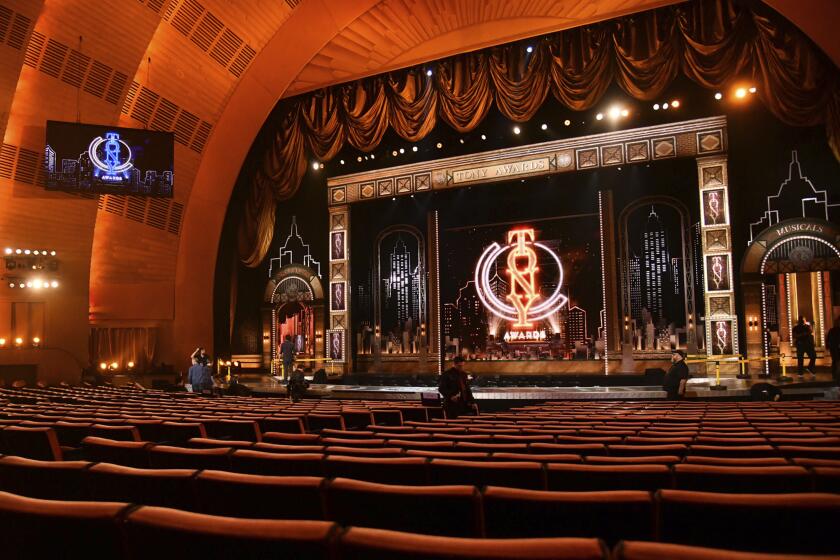ARTS BEAT / HILLARD HARPER : O’Connor on Tightrope With Soviet Arts Festival
- Share via
Mayor Maureen O’Connor’s scheme to bring a Soviet arts and culture fest to San Diego in 1989 is, as the saying goes, going down. The San Diego City Council on Monday voted 6-2 to spring for $3 million of the proposed $6.25 million budget, and those eggs and icons we’ve been hearing about are in the oven.
But, if the mood and turnout at Monday’s council sessions is any indication, the mayor’s victory hangs from a very thin strand of support and her extravagant claims for promoting the arts in San Diego are far from a political reality.
Although about 50 people, including a few representatives of mainstream arts groups, spoke in favor of the festival (about a dozen spoke against it), the turnout from the arts community was minuscule for an event of its size.
More ironic, Abbe Wolfsheimer, the City Council member who has the most experience and strongest connection with the arts, was one of two council members to vote against funding the festival. Wolfsheimer said that only $800,000 of the fest’s $6.25 million budget would go to local arts groups.
Monday’s City Council meeting captured the sense of the fog surrounding the festival, of the possibilities and the uncertainties.
Although O’Connor maintains that the festival is a popular cause, a petition against the festival, bearing 1,000 signatures was unrolled in the council chamber, testimony to strong local resistance.
Debra Schettino, who works for Free Afghanistan Alliance, a group that provides aid for Afghan refugees in this country, charged that O’Connor has created “a major public relations problem that won’t easily be forgotten.”
The major criticism of the mayor’s handling of the festival, as detailed in a Times Calendar story Friday, is her disregard for the opinions of arts leaders who are not heads of the four or five major professional organizations in the city. Although she and her press secretary Paul Downey insisted last week that she had consulted arts leaders, virtually no one other than those in the golden circle said they had been asked for their opinions, and none of the golden circle members had been contacted before O’Connor first announced plans to host a Soviet arts festival.
Hugh Davies, director of the La Jolla Museum of Contemporary Art, Steven Brezzo, director of the San Diego Museum of Art, Ian Campbell, general director of the San Diego Opera, Wesley O. Brustad, executive director of the San Diego Symphony; Des McAnuff of the La Jolla Playhouse and Arthur Ollman, director of the Museum of Photographic Arts, also said they had not been asked for their opinions about a Soviet arts festival before the mayor’s State of the City Address at the Old Globe in January.
After the State of the City talk, O’Connor put together a steering committee that did include many of these leaders, but that group hasn’t met since her highly publicized arts trip to Russia this summer.
As of today, little is known about this festival. Exactly which Soviet artists and artisans are coming and who is going to choose them.
Although the Imperial Faberge eggs are presumably chosen, specific icons have not been. Who is going to pick them, and how big will the icons exhibit be? The director of the San Diego Museum of Art said on Monday he hadn’t heard a peep from the mayor’s office about such matters.
The next step, O’Connor’s aides say, is for her to appoint a festival advisory panel of community leaders, and for a festival coordinator to be chosen. They estimate that this will take several weeks. Next month, a representative of the Soviet Ministry of Culture will be in San Diego for further talks and negotiations.
But O’Connor’s handling of the festival’s planning to date--in the choice and scale of many of the events such as the exhibits of religious icons and Imperial Faberge Eggs--has the earmarks of an amateur who is far less sophisticated than the arts community she wants to put on the world stage.
No arts leaders have ranked the 19-element festival in the world-class league, which O’Connor vowed it would be.
Apparently making several of the selections herself, rather than turning them over to the city’s arts professionals or a professional arts festival director, O’Connor set a political precedent of making artistic decisions, a precedent that turned around and bit her Monday when the City Council got into the act.
Responding to criticisms that the festival ignores victims of the Soviet Union’s human rights violations, the City Council, Monday, allocated 1% of the festival’s city funds ($30,000) for an alternative festival.
The last time a local political body sought to actively promote the arts in San Diego--with the San Diego Unified Port District’s public arts program--it ended in national embarrassment.
The Port commissioners were all in favor of public art on Port lands, but had a quick change of heart when vocal elements of the public opposed their professional arts advisory board’s contemporary art selections.
The mayor’s and the City Council’s desires to support and promote the arts are welcomed by all San Diegans who care about the city’s cultural life. But, historically, the City Council here does not have a very good record when it comes to following the advice of experts--in any field.
Years ago, the waste experts were ignored when they said San Diego’s sewage disposal system needed updating. Now San Diego is facing a $1-billion price tag for federally mandated sewer improvements.
One hopes that O’Connor and the council will continue to champion the concept of arts festivals and to insist that the artistic decisions from here on be made by arts experts.
More to Read
The biggest entertainment stories
Get our big stories about Hollywood, film, television, music, arts, culture and more right in your inbox as soon as they publish.
You may occasionally receive promotional content from the Los Angeles Times.










